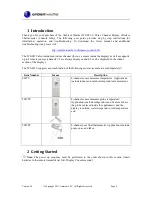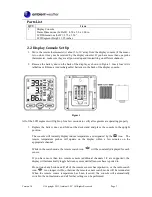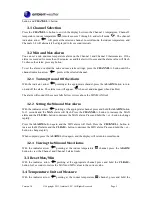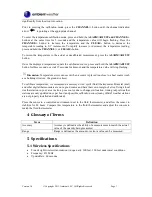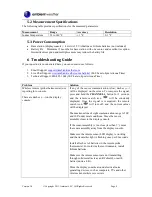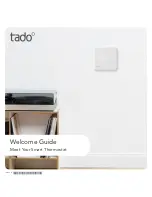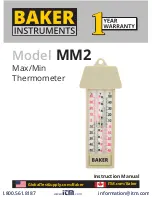
Version 1.0
©Copyright 2013, Ambient LLC. All Rights Reserved.
Page 6
ALARM
button for 3 seconds to change between degrees Celsius and degrees Fahrenheit units of
measure.
3.5 Sensor Search Mode
If any of the sensor communication is lost, dashes (--.-) will be displayed on the screen. To reacquire
the signal:
1.
If a specific channel is lost, press the
C
button until the channel indication arrow
is pointing at the appropriate channel.
Press and hold the
C
button for 3 seconds, and the remote search icon
will
be constantly displayed for up to 10 minutes.
Once the signal is reacquired, the remote search icon
will turn off, and the current value
will be displayed.
2.
If new sensors are added, subtracted, or multiple sensor channels are lost, press the
C
button until the channel indication arrow
is pointing at the indoor
temperature
. Press and hold the
C
button for 3 seconds, and the remote
search icon
will be constantly displayed for up to 10 minutes. Once the signal is
reacquired, the remote search icon
will turn off, and the current value will be displayed.
3.6 Best Practices for Wireless Communication
Wireless communication is susceptible to interference, distance, walls and metal barriers. We
recommend the following best practices for trouble free wireless communication.
1.
Electro-Magnetic Interference (EMI)
. Keep the console several feet away from computer
monitors and TVs.
2.
Radio Frequency Interference (RFI).
If you have other 433 MHz devices and
communication is intermittent, try turning off these other devices for troubleshooting
purposes. You may need to relocate the transmitters or receivers to avoid intermittent
communication.
3.
Line of Sight Rating.
This device is rated at 300 feet line of sight (no interference, barriers or
walls) but typically you will get 100 feet maximum under most real-world installations,
which include passing through barriers or walls.
4.
Metal Barriers.
Radio frequency will not pass through metal barriers such as aluminum
siding. If you have metal siding, align the remote and console through a window to get a clear
line of sight.
3.7 Adjustment or Calibration
Note:
The calibrated value can only be adjusted on the console. The remote sensor(s) always
displays the un-calibrated or measured value.
Note:
The purpose of calibration is to fine tune or correct for any sensor error associated with the
devices margin of error. The measurement can be adjusted from the console to calibrate to a known
source.
Calibration is only useful if you have a known calibrated source you can compare it against, and is
optional. This section discusses practices, procedures and sources for sensor calibration to reduce
manufacturing and degradation errors. Do not compare your readings obtained from sources such as
the internet, radio, television or newspapers. They are in a different location and typically update once
per hour.
The purpose of your weather station is to measure conditions of your surroundings, which vary


